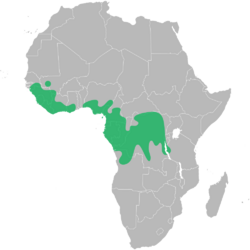Biology:Anthonotha
| Anthonotha | |
|---|---|
| Scientific classification | |
| Kingdom: | Plantae |
| Clade: | Tracheophytes |
| Clade: | Angiosperms |
| Clade: | Eudicots |
| Clade: | Rosids |
| Order: | Fabales |
| Family: | Fabaceae |
| Subfamily: | Detarioideae |
| Tribe: | Amherstieae |
| Genus: | Anthonotha P.Beauv. |
| Type species | |
| Anthonotha macrophylla P.Beauv., 1806
| |
| Species | |
|
17; see text | |

| |
| Anthonotha distribution map.[1] | |
Anthonotha is a genus within the subfamily Detarioideae of the plant family Fabaceae.
Taxonomic history
The first species of the genus was described in 1806 by Palisot de Beauvois based on a specimen collected in West Africa and named Anthonotha macrophylla P.Beauv.[2] The genus was not recognized and in 1865 Henri Baillon transferred it to the South American genus Vouapa, described by Jean Baptiste Aublet in 1775.[3] Vouapa later became a junior synonym since the conserved name of Macrolobium was favored for the genus described by Johann Schreber in 1789.
Most species now recognized within Anthonotha were originally described within the genus Macrolobium. The species Anthonotha macrophylla continued under the illegitimate name Macrolobium palisotii described by Bentham in 1865.[4] This was corrected by James Macbride in 1919 by publishing the correct name M. macrophyllum (P.Beauv.) Macbride.[5]
In 1955 Léonard reinstalled Anthonotha for the rest of the African Macrolobium species, after several other species had been transferred to his newly described genera Gilbertiodendron, Paramacrolobium, and Pellegrineodendron.[6][7] Léonard subclassified the reinstalled Anthonotha with 26 species into five sections.[8][9] Anthonotha section Anthonotha became the genus Anthonotha in a new, narrow sense.[10]
The species of the other four sections of Anthonotha were placed in the genera Isomacrolobium and Englerodendron by Breteler.[7][11] Isomacrolobium was later synonymized with Englerodendron.[12][13]
A prehistoric species, Anthonotha shimaglae, has been reported from the early Miocene of Ethiopia and is a component of an ancient forest dominated by Englerodendron.[14][15]
Species
Anthonotha contains the following species:[1]
- Anthonotha acuminata (De Wild.) J.Léonard, 1957
- Anthonotha brieyi (De Wild.) J.Léonard, 1957
- Anthonotha cladantha (Harms) J.Léonard, 1955
- Anthonotha crassifolia (Baill.) J.Léonard, 1955
- Anthonotha ferruginea (Harms) J.Léonard, 1955
- Anthonotha fragrans (Baker f.) Exell & Hillc., 1955
- Anthonotha gilletii (De Wild.) J.Léonard, 1957
- Anthonotha lamprophylla (Harms) J.Léonard, 1955
- Anthonotha macrophylla P.Beauv., 1806
- Anthonotha mouandzae Breteler, 2010
- Anthonotha noldeae (Rossberg) Exell & Hillc., 1955
- Anthonotha pellegrinii Aubrév., 1968
- Anthonotha pynaertii (De Wild.) Exell & Hillc., 1955
- †Anthonotha shimaglae Pan, Jacobs, Currano, Estrella, Herendeen et Burgt, 2023 - extinct
- Anthonotha stipulacea (Benth.) J.Léonard, 1955
- Anthonotha trunciflora (Harms) J.Léonard, 1955
- Anthonotha wijmacampensis Breteler, 2010
- Anthonotha xanderi Breteler, 2010
Phylogeny
The following relationships have been suggested for the genus Anthonotha:[13]
| |||||||||||||||||||||||||||||||||||||||||||||||||||||||||||||||||||||||||||||||||||||||||||||||||||||||
References
- ↑ 1.0 1.1 Breteler FJ. (2010). "Revision of the African genus Anthonotha (Leguminosae, Caesalpinioideae)". Plant Ecology and Evolution 143 (1): 70–99. doi:10.5091/plecevo.2010.369.
- ↑ Palisot de Beauvois AMFJ. (1806). Flore d'Oware et de Benin en Afrique, I. Paris: Fain et Compagnie. doi:10.5962/bhl.title.101798.
- ↑ Baillon H. (1865). "Études sur l'Herbier du Gabon du Musée des Colonies Françaises". Adansonia 6: 177–230. ISSN 1954-6475.
- ↑ Bentham G. (1866). "IX. Description of some new genera and species of tropical Leguminosae". Transactions of the Linnean Society of London 25 (2): 297–320 (plates 36–43). doi:10.1111/j.1096-3642.1865.tb00186.x. https://zenodo.org/record/2342907.
- ↑ Macbride JF. (1919). "Notes on certain Leguminosae". Contributions from the Gray Herbarium of Harvard University 59 (59): 1–27. doi:10.5962/p.336032.
- ↑ Léonard J. (1955). "Notulae Systematicae XVII. Les genres Anthonotha P.Beauv. et Pellegriniodendron J.Léonard en Afrique Tropicale (Caesalpiniaceae)". Bulletin du Jardin Botanique de l'État à Bruxelles 25 (2): 201–203. doi:10.2307/3667066.
- ↑ 7.0 7.1 Breteler FJ. (2006). "Novitates Gabonenses 56. Two Anthonotha species from Gabon transferred to Englerodendron (Fabaceae, Caesalpinioideae)". Adansonia 28 (7): 105–111. http://sciencepress.mnhn.fr/en/periodiques/adansonia/28/1/novitates-gabonenses-56-deux-especes-d-anthonotha-du-gabon-transferees-englerodendron-fabaceae-caesalpinioideae.
- ↑ Léonard J. (1957). "Genera des Cynometreae et des Amherstieae africaines (Léguminosae-Caesalpinioideae). Essai de blastogenie appliqué à la systématique.". Mémoires de l'Académie Royale de Sciences, Lettres et Beaux-Arts de Belgique. Classe des Sciences [in octavo] 30 (2): 1–314.
- ↑ Léonard J. (1996). "Les délimitations des genres chez les Caesalpinioideae africaines (Detarieae et Amherstieae) (1957–1994)". The biodiversity of African Plants (Proceedings of the 14th AETFAT Congress, 22–27 August 1994, Wageningen, The Netherlands). Dordrecht, Netherlands: Kluwer, Academic Publishers. pp. 443–455. ISBN 978-94-009-0285-5. https://www.springer.com/gp/book/9780792340959.
- ↑ "De quelques Césalpiniées africaines". Bulletin de la Société Botanique de France 104 (7–8): 495–498. 1957. doi:10.1080/00378941.1957.10835136. Bibcode: 1957BSBF..104..495A. in Aubréville A. (1959). La flore forestière de la Côte d'Ivoire. Paris, France: Centre Technique Forestier Tropical. pp. 280. ISBN 978-2-841-07020-6.
- ↑ Breteler FJ. (2008). "Anthonotha and Isomacrolobium (Leguminosae, Caesalpinioideae): Two distinct genera". Systematics and Geography of Plants 78 (2): 137–144. https://www.ingentaconnect.com/content/nbgb/sgp/2008/00000078/00000002/art00001.
- ↑ "Phylogenomic analyses reveal an exceptionally high number of evolutionary shifts in a florally diverse clade of African legumes". Mol Phylogenet Evol 137: 156–167. 2019. doi:10.1016/j.ympev.2019.05.002. PMID 31075505.
- ↑ 13.0 13.1 "Re-evaluation of the genus Englerodendron (Leguminosae–Detarioideae), including Isomacrolobium and Pseudomacrolobium". Aust Syst Bot 32 (6): 564–571. 2019. doi:10.1071/SB18075. https://www.publish.csiro.au/sb/Fulltext/SB18075.
- ↑ Pan, Aaron D.; Jacobs, Bonnie F.; Currano, Ellen D.; Estrella, Manuel de la; Herendeen, Patrick S.; van der Burgt, Xander M. (2023-09-01). "A Fossil Anthonotha (Leguminosae: Detarioideae: Amherstieae) Species from the Early Miocene (21.73 Ma) of Ethiopia" (in en). International Journal of Plant Sciences 184 (7): 541–548. doi:10.1086/725429. ISSN 1058-5893. https://www.journals.uchicago.edu/doi/10.1086/725429.
- ↑ Pan, Aaron D.; Jacobs, Bonnie F.; Bush, Rosemary T.; Estrella, Manuel de la; Grímsson, Friðgeir; Herendeen, Patrick S.; Burgt, Xander M. van der; Currano, Ellen D. (2023-01-11). "First evidence of a monodominant (Englerodendron, Amherstieae, Detarioideae, Leguminosae) tropical moist forest from the early Miocene (21.73 Ma) of Ethiopia" (in en). PLOS ONE 18 (1): e0279491. doi:10.1371/journal.pone.0279491. ISSN 1932-6203. PMID 36630378. Bibcode: 2023PLoSO..1879491P.
Wikidata ☰ Q4771933 entry
 |

